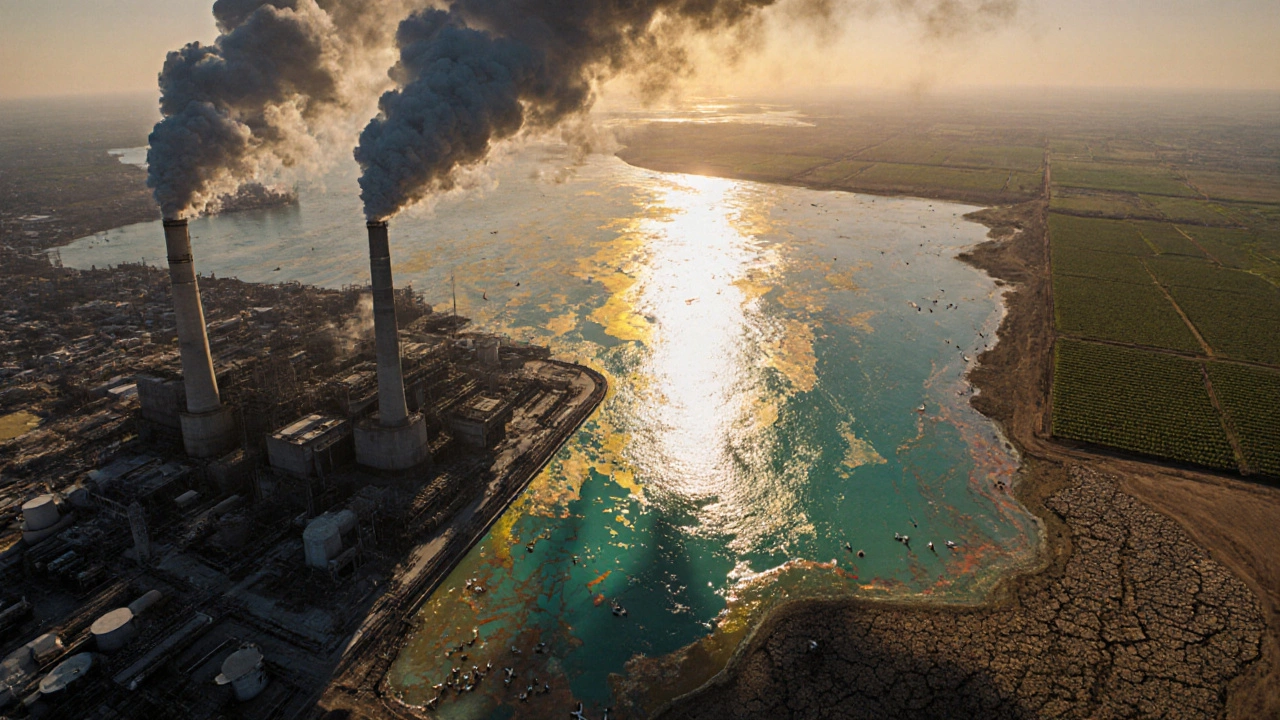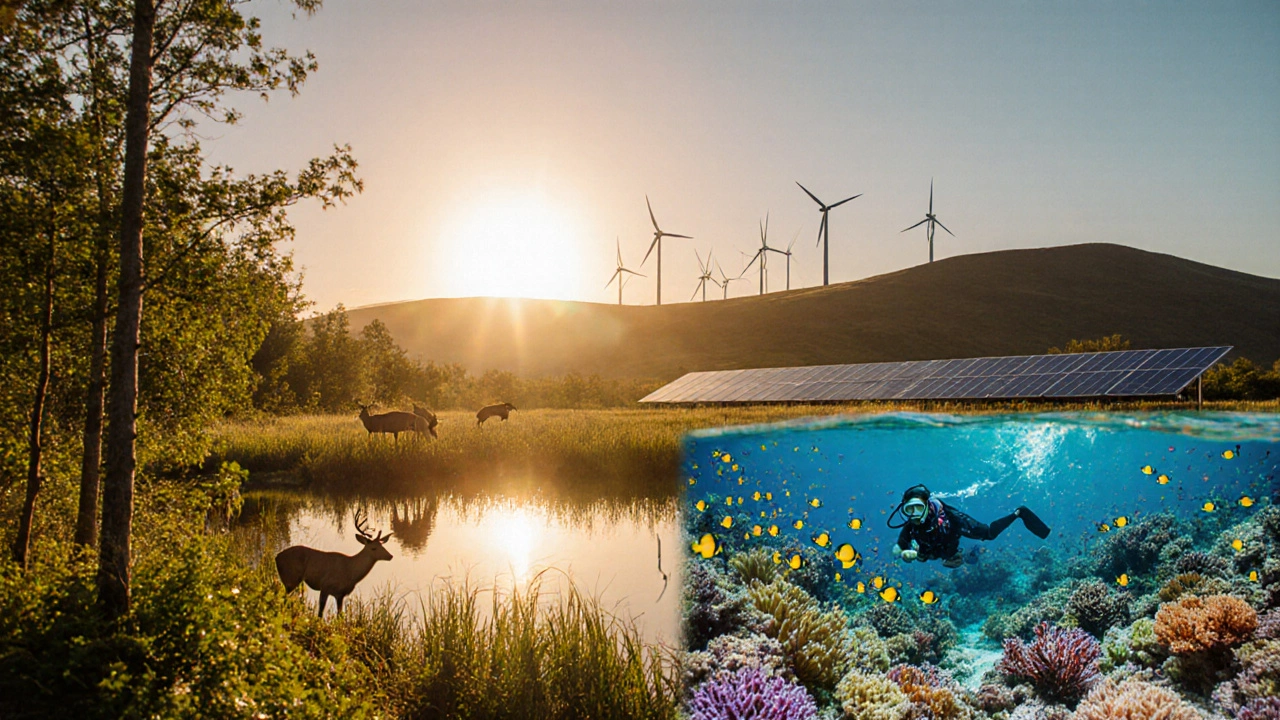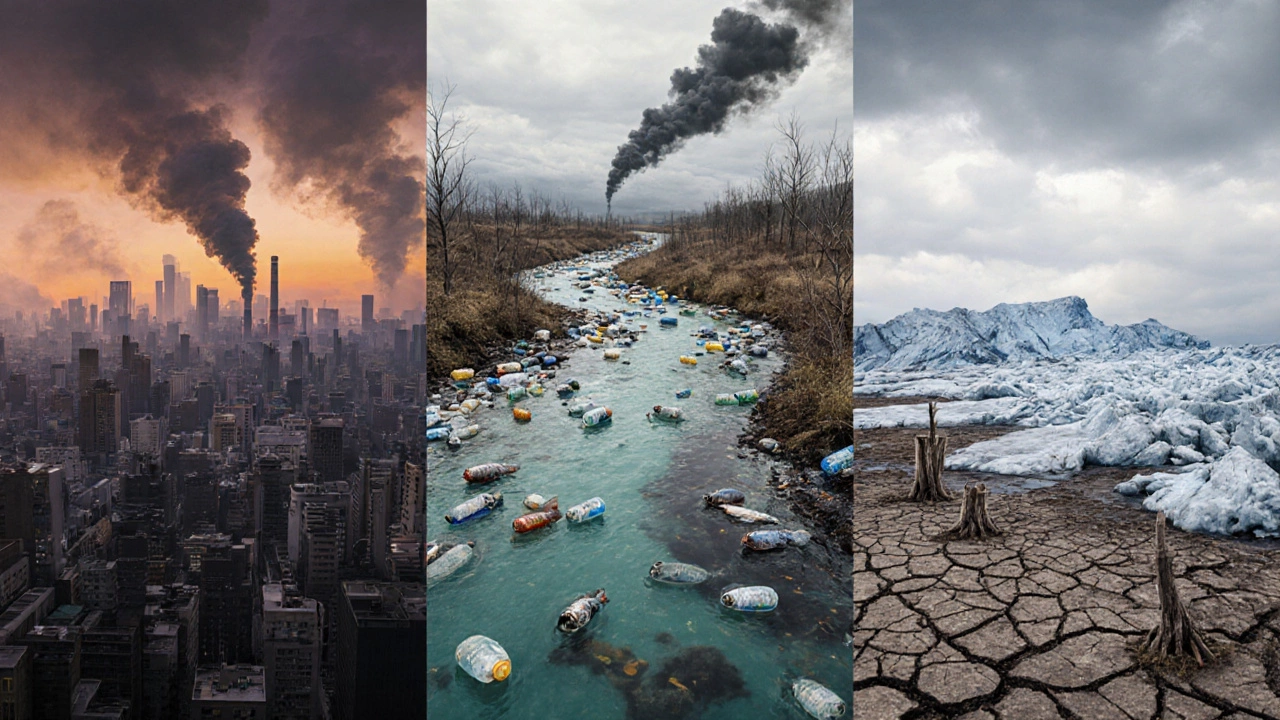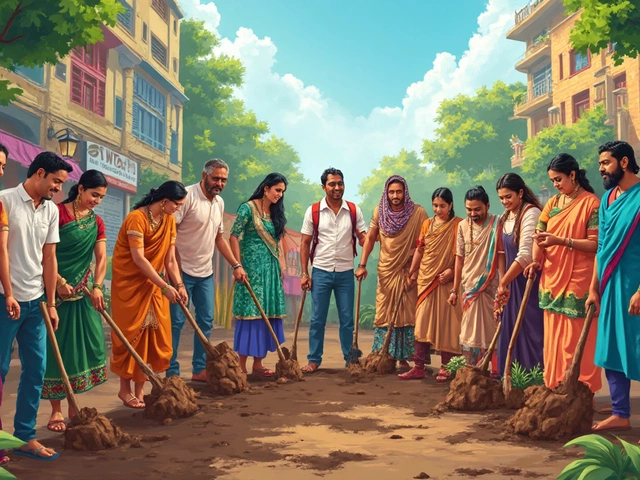Environmental Problem Groups Explorer
Select a category below to learn more about its characteristics, impacts, and solutions.
Pollution
Contamination of air, water, and soil with harmful substances.
Resource Depletion
Overuse of finite natural resources like fossil fuels and water.
Habitat Loss & Climate Change
Ecosystem destruction and global climate shifts.
When you hear the term environmental problems, you might picture a single issue like plastic waste or global warming. In reality, experts sort these challenges into three big buckets that help us see patterns, compare impacts, and plan actions. Understanding the three main environmental problem groups-pollution, resource depletion, and habitat loss (including climate change)-gives you a clear roadmap for what’s causing damage and how to tackle it.
1. Pollution: The Direct Dump of Harmful Substances
Pollution is a type of environmental problem that occurs when unwanted chemicals, particles, or energy enter natural systems, causing adverse effects on living organisms and ecosystems. It shows up in three classic media:
- Air pollution (description: the release of gases like sulfur dioxide, nitrogen oxides, and particulate matter that degrade air quality). Major sources include vehicle exhaust, coal‑fired power plants, and industrial processes. The World Health Organization reports that outdoor air pollution contributes to 4.2 million premature deaths each year.
- Water pollution (description: contamination of rivers, lakes, and oceans by chemicals, nutrients, and waste). Agricultural runoff rich in nitrogen and phosphorous fuels harmful algal blooms, while plastic debris chokes marine life. According to a 2024 UN study, an estimated 5 trillion pieces of plastic float in the ocean.
- Soil contamination (description: accumulation of heavy metals, pesticides, and industrial waste in the ground). This reduces soil fertility, threatens food security, and can leach into groundwater. In some industrial regions, lead levels in soil exceed safe limits by 10‑fold.
Pollution’s impacts are immediate and observable: smog‑filled skylines, fish kills, and barren farmland. Mitigation relies on stricter regulations, cleaner technologies, and personal choices like using public transport or reducing single‑use plastics.
2. Resource Depletion: Consuming Finite Supplies Faster Than They Regenerate
Resource depletion refers to the unsustainable extraction and use of natural assets such as minerals, fossil fuels, and freshwater, leading to scarcity and ecological imbalance. Key sub‑categories include:
- Energy consumption (description: reliance on non‑renewable fossil fuels like coal, oil, and natural gas). The International Energy Agency noted that in 2023, fossil fuels still accounted for 80% of global energy demand, driving CO₂ emissions.
- Water scarcity (description: over‑extraction of freshwater for agriculture, industry, and domestic use). By 2025, 2.1billion people face high water stress, according to the World Bank.
- Raw material exhaustion (description: mining of metals like copper, lithium, and rare earth elements at rates faster than geological replenishment). The rapid rise of electric‑vehicle batteries has tripled lithium demand since 2018.
Depletion isn’t just a future worry-it already drives price spikes, geopolitical tension, and ecosystem collapse. Transitioning to renewable energy (description: power generated from solar, wind, hydro, and geothermal sources) and improving water‑use efficiency are proven ways to slow the drain.

3. Habitat Loss & Climate Change: The Slow Erosion of Ecosystem Integrity
Habitat loss is an environmental problem that occurs when natural areas are converted for human use, leading to biodiversity decline and ecosystem disruption. Climate change amplifies this loss, creating a feedback loop that threatens the planet’s life‑support systems.
- Deforestation (description: clearing of forests for agriculture, logging, and urban expansion). The FAO reports that we lose roughly 10million hectares of forest each year.
- Overfishing (description: harvesting fish stocks faster than they can replenish). The Marine Stewardship Council estimates that 34% of global fish stocks are overexploited.
- Climate change (description: long‑term rise in average temperatures due to greenhouse‑gas emissions, altering precipitation patterns and sea levels). 2023 marked the hottest year on record, with Arctic sea ice at a historic low.
- Biodiversity loss (description: the rapid decline of species diversity, measured by the extinction rate). Current estimates suggest extinction rates are 100‑1,000 times higher than natural background levels.
When habitats shrink, species lose food sources, breeding grounds, and protection from predators. Climate change adds stress by shifting temperature zones, causing coral bleaching and melting permafrost. Conservation efforts-protected areas, reforestation, and sustainable fisheries-combined with aggressive emissions cuts, are essential to halt the spiral.
Comparing the Three Problem Groups
| Aspect | Pollution | Resource Depletion | Habitat Loss & Climate Change |
|---|---|---|---|
| Primary Driver | Release of harmful substances | Over‑extraction of finite assets | Land‑use change & greenhouse‑gas emissions |
| Typical Examples | Smog, oil spills, pesticide runoff | Fossil‑fuel consumption, groundwater overdraft | Deforestation, sea‑level rise, coral bleaching |
| Immediate Impacts | Health issues, water contamination | Resource shortages, price spikes | Species extinction, ecosystem destabilization |
| Long‑Term Risks | Chronic disease burden, ecosystem toxicity | Economic insecurity, geopolitical conflict | Irreversible loss of biodiversity, climate tipping points |
| Key Mitigation Strategies | Regulation, clean tech, waste reduction | Renewables, circular economy, water‑saving tech | Protected areas, reforestation, emission cuts |

Practical Steps You Can Take Today
Knowing the three groups helps you pick actions that hit multiple problems at once. Here are three low‑hanging moves, each targeting a different group:
- Cut your personal waste footprint. Choose refillable bottles, avoid single‑use plastics, and recycle correctly. This reduces pollution and eases pressure on raw‑material extraction.
- Shift energy habits. Install LED bulbs, use a smart thermostat, or switch to a green electricity plan. Lowering fossil‑fuel demand tackles resource depletion and curbs climate‑change emissions.
- Support habitat protection. Donate to or volunteer with organizations that purchase land for reforestation, protect wetlands, or enforce sustainable fishing quotas. Your involvement directly counters habitat loss.
Every small decision adds up. When many people act, the cumulative effect can turn a local breeze into a global shift.
Frequently Asked Questions
What exactly counts as pollution?
Pollution includes any contaminant-chemical, physical, or biological-released into air, water, or soil that harms living organisms or the environment. Common examples are carbon monoxide from cars, fertilizer runoff into rivers, and heavy metals left in soil after industrial waste.
Why is resource depletion considered an environmental problem?
When we extract resources faster than Earth can replenish them, we create scarcity, drive up prices, and often trigger ecological side‑effects-like habitat destruction from mining or reduced river flow from groundwater pumping. These outcomes spill over into social and economic realms, making resource depletion a core environmental issue.
How does habitat loss differ from climate change?
Habitat loss is the direct removal or alteration of ecosystems-like clearing forests for farmland. Climate change, meanwhile, is a global shift in temperature and weather patterns driven mainly by greenhouse‑gas emissions. The two interact: a hotter climate can worsen habitat loss by increasing droughts, fires, and sea‑level rise.
Which of the three problem groups is the hardest to solve?
All three are tough, but habitat loss coupled with climate change often ranks highest because it involves deep‑rooted economic activities (agriculture, urban expansion) and long‑term planetary feedback loops. Solving it requires coordinated policy, large‑scale land restoration, and rapid decarbonization.
Can individuals really make a difference?
Yes. Collective consumer choices shift market demand, pressure legislators, and fund conservation projects. Small changes-using less plastic, saving energy, supporting sustainable brands-multiply when millions adopt them, creating measurable drops in pollution, resource use, and habitat pressure.






